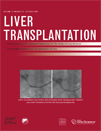Reconstruction of the suprahepatic cuff injured during multiorgan procurement using the infrahepatic vena cava of the liver allograft
The principal technical issue during a combined heart-liver organ procurement is in the sectioning of the suprahepatic inferior vena cava (IVC). The key point is to ensure a sufficient inferior caval stump for both organs. From experience with domino liver transplantation, which is performed routinely in the care of familial amyloidosis, the surgeon's community has learned some technical innovations to overcome the cuff limitation that is commonly present, reconstructing the outflow of the domino graft.1 Possible strategies reported to ameliorate the upper cava problem have included the infrahepatic cava as primary anastomosis, using and then sewing the suprahepatic IVC or using a vein patch2, 3 and extending the cuff with a vein graft and then performing an end-to-side cavocavostomy.4 We report a particular case in which during a combined heart-liver organ procurement, the cardiac surgery team inadvertently transected the suprahepatic IVC near the emergence of the suprahepatic veins of the liver. Herein we describe a new technique to repair this injury, extending the cuff of the IVC with a branch of the infrahepatic IVC of the allograft and performing a standard piggyback liver transplant.
Abbreviation
IVC, inferior vena cava.
BACK-TABLE PREPARATION OF THE HEPATIC ALLOGRAFT
Following the recovery, the allograft was flushed with 1 L of Celsior (IMTIX-SangStat, Lyon, France) through the portal vein. The details of the back-table technique are described elsewhere.5 The IVC was inspected, and it was judged to be inappropriate to oversew it or to use a vein patch to carry out an end-to-side infrahepatic cavocavostomy. In fact, the cuff was so short that the risk of obstructing the outflow from the hepatic vein was too high (Fig. 1). The possibility of using the common iliac vein previously harvested from the donor was then verified, but the discrepancy of the size did not guarantee a watertight anastomosis. In addition, a small segment of the donor's infrarenal IVC was not available because the donor's team did not recover a useful trunk. Therefore, it was decided to use a patch of the infrahepatic IVC from the allograft. The intrahepatic IVC was mobilized and extended by legation of the short hepatic vein between the liver and the IVC. A useful segment of IVC was transected and used to extend the cuff. To carry out the anastomosis, the conventional parachute technique was used (Fig. 2). The anastomosis was performed with two running sutures with 5/0 Prolene (Ethicon, Inc.; Fig. 3).

The injury on the suprahepatic IVC of the allograft after the harvest of the liver. The red arrows show the anterior wall of IVC completely transected.

Back-table of the infrahepatic IVC of the allograft. The IVC was extended as much it was possible to achieve a useful patch of the IVC to transect (on the left) and to use to reconstruct the cuff of the hepatic vein with the parachute technique (on the right).

Reconstruction of the stump of suprahepatic IVC was performed with double running sutures (on the left). Adequate patency of the hepatic veins (on the right).
TRANSPLANTATION OF THE HEPATIC ALLOGRAFT
The implantation was performed by the standard piggyback technique as described elsewhere.6 The remaining inferior IVC was long enough to be tied. After that, the liver was reperfused.
To the best of our knowledge, this is the first description of the use of an intrahepatic IVC segment from the allograft to reconstruct the suprahepatic venous cuff injured during a multiorgan procurement. We believe that this technique is simple and safe and should be used every time that the other options are not feasible or cadaveric vein segments are unobtainable. In our case, the remaining IVC is tied but can be sutured in case it is not long enough.




